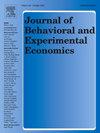聚会规模和用餐时间对付小费行为的影响
IF 1.4
3区 经济学
Q2 ECONOMICS
Journal of Behavioral and Experimental Economics
Pub Date : 2025-05-21
DOI:10.1016/j.socec.2025.102386
引用次数: 0
摘要
在这项研究中,我们提出了一个理论框架来解释聚会规模和用餐时间如何影响小费行为。该框架表明,聚会规模和用餐时间的影响都是小山形的,因此应该非线性建模。我们使用来自大型事务数据库的数据(n >;为一家挪威连锁餐厅测试提议的效果。我们还将这些数据与样本中60家披萨店的服务员特征和顾客评级信息合并在一起。结果表明,宴会规模和用餐时间对小费行为的影响是非线性的。这两个变量和小费之间的关系大多呈倒u型。然而,这两种影响都是相互依存的:账单的大小、顾客的评分和酒精消费的存在。本文章由计算机程序翻译,如有差异,请以英文原文为准。
The effects of party size and dining duration on tipping behavior
In this study, we propose a theoretical framework to explain how party size and dining duration affect tipping behavior. The framework suggests that both the party size and the dining duration effects are hill-shaped and thus should be modeled nonlinearly. We use data from a large-scale transaction database (n > 800,000) for a Norwegian restaurant chain to test the proposed effects. We also merge these data with information on waiter characteristics and customer ratings for the 60 pizza restaurants in the sample. In line with the theoretical propositions, the results show that party size and dining duration affect tipping behavior nonlinearly. The association between both variables and tipping is mostly inversely U-shaped. Yet both effects are contingent on each other, the size of the bill, customer ratings, and the presence of alcohol consumption.
求助全文
通过发布文献求助,成功后即可免费获取论文全文。
去求助
来源期刊
CiteScore
2.60
自引率
12.50%
发文量
113
审稿时长
83 days
期刊介绍:
The Journal of Behavioral and Experimental Economics (formerly the Journal of Socio-Economics) welcomes submissions that deal with various economic topics but also involve issues that are related to other social sciences, especially psychology, or use experimental methods of inquiry. Thus, contributions in behavioral economics, experimental economics, economic psychology, and judgment and decision making are especially welcome. The journal is open to different research methodologies, as long as they are relevant to the topic and employed rigorously. Possible methodologies include, for example, experiments, surveys, empirical work, theoretical models, meta-analyses, case studies, and simulation-based analyses. Literature reviews that integrate findings from many studies are also welcome, but they should synthesize the literature in a useful manner and provide substantial contribution beyond what the reader could get by simply reading the abstracts of the cited papers. In empirical work, it is important that the results are not only statistically significant but also economically significant. A high contribution-to-length ratio is expected from published articles and therefore papers should not be unnecessarily long, and short articles are welcome. Articles should be written in a manner that is intelligible to our generalist readership. Book reviews are generally solicited but occasionally unsolicited reviews will also be published. Contact the Book Review Editor for related inquiries.

 求助内容:
求助内容: 应助结果提醒方式:
应助结果提醒方式:


